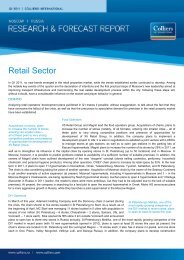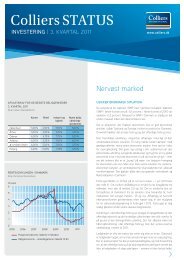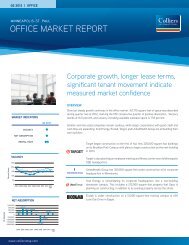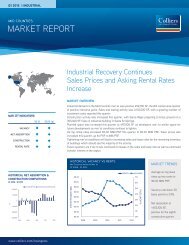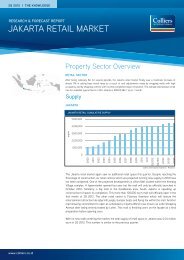Österreich 2013 - Colliers International
Österreich 2013 - Colliers International
Österreich 2013 - Colliers International
Erfolgreiche ePaper selbst erstellen
Machen Sie aus Ihren PDF Publikationen ein blätterbares Flipbook mit unserer einzigartigen Google optimierten e-Paper Software.
Marktbericht | Zinshäuser | <strong>2013</strong><br />
Zinshäuser in Wien<br />
Apartment Buildings in Vienna<br />
Geprägt durch das über 100 Jahre alte<br />
österreichische Mietrecht (MRG), welches<br />
zum damaligen Zeitpunkt wirtschaftlich und<br />
sozial politisch wegweisend war, ist der Zinshausmarkt<br />
bis in die jüngste Zeit ein rein<br />
nationaler Markt für Anleger gewesen. Erst<br />
mit den Anfängen der Wirtschaftskrise wurde<br />
diese Immobiliensparte langsam auch von<br />
ausländischen Investoren entdeckt, wenngleich<br />
nach wie vor österreichische Privatpersonen<br />
und Unternehmungen für ca. 95 %<br />
des Transaktionsvolumens verantwortlich<br />
zeich nen.<br />
Basierend auf der Definition des Wiener<br />
Zinshauses – „Wohn- und Geschäftshäuser,<br />
welche zwischen 1848 und 1920 in geschlossener<br />
Bauweise errichtet wurden“ –<br />
und durch stark gestiegene Wohnungspreise<br />
im Eigentumssegment – werden immer mehr<br />
Althäuser in Wohnungseigentum umgewandelt.<br />
Sowohl durch diesen Trend als auch durch<br />
Abbruch geht jedes Jahr ca. 1 % des Wiener<br />
Gesamtbestandes verloren, sodass es derzeit<br />
nur mehr ca. 14.900 klassische Gründerzeit-<br />
Zinshäuser in Wien gibt. Klassischerweise ist<br />
bei einer Marktsituation, bei der es einen<br />
extremen Nachfrageüberhang gibt, die Ware<br />
aber nicht reproduzierbar ist, sondern<br />
geringer wird, mit weiteren Preissteigerungen<br />
zu rechnen.<br />
Aufgrund des Mietrechtsgesetzes ist jedoch die<br />
Miet zinsgestaltung gesetzlich streng reglementiert.<br />
Die Mietpreise können sich daher nicht<br />
analog zu den Eigentumspreisen entwickeln und<br />
die Renditen werden weiter sinken.<br />
Andererseits haben die letzten Jahre gezeigt,<br />
dass diese reglementierten Mieten nicht<br />
marktkonform sind und somit teilweise große<br />
stille Reserven vorhanden sind, weshalb<br />
Investoren verstärkt unter dem Aspekt der<br />
Vermögens- und Wert erhaltung investieren.<br />
Im Jahr 2012 lag das Transaktionsvolumen bei<br />
ca. 1 Milliarde Euro (ausschließlich Asset Deals,<br />
da Share Deals statistisch schwer erfasst<br />
werden können). Basierend auf den bisherigen<br />
Daten wird das Volumen <strong>2013</strong> gleich bleiben,<br />
wenn gleich die Anzahl der Verkäufe (bedingt<br />
durch ein verringertes Angebot) rückläufig ist.<br />
The Austrian Landlord-Tenant Act (MRG) is<br />
over 100 years old. At the time, it was<br />
groundbreaking in terms of economics and<br />
social politics. It still shapes the market for<br />
rental dwellings to this day, which has been<br />
a true national market for investors. Only<br />
with the beginning of the economic crisis,<br />
this real estate segment was discovered<br />
slowly by foreign investors even if private<br />
Austrian citizens and companies continue to<br />
be still responsible for approx. 95 % of the<br />
transaction volume.<br />
The Vienna rental dwelling is defined as<br />
“residential and commercial building<br />
constructed as one closed unit between the<br />
years 1848 and 1920”. Through the strong<br />
increase in apartment prices in the<br />
condominium segment more and more<br />
existing buildings are converted to<br />
condominiums. This trend and demolition are<br />
responsible for the annual loss of approx. 1 %<br />
of the Vienna inventory of rental dwellings.<br />
Currently, there are only a little over about<br />
14,900 traditional Gründerzeit rental dwellings<br />
left in Vienna. In a market situation with<br />
excess demand, the product can traditionally<br />
not be reproduced. Instead, the supply drops<br />
and therefore, further price increases are<br />
preprogrammed.<br />
Based on the above-referenced landlordtenant<br />
act, it must be taken into account that<br />
the rent amount is strictly regulated by law.<br />
Therefore, rental prices cannot develop<br />
analogous to owned property prices and the<br />
yields will continue to drop.<br />
Over the past years, it has been shown that<br />
these regulated rent amounts are non-marketcompliant<br />
and therefore a considerable amount<br />
of hidden assets exists. For this reason,<br />
investors have increasingly invested under the<br />
aspect of asset and value preservation.<br />
In 2012, the transaction volume was approx.<br />
1 billion Euros (only the asset deals because<br />
share deals are statistically difficult to capture).<br />
Based on the data so far, the volume can be<br />
seen as steady in <strong>2013</strong>, even if the number of<br />
purchases is decreasing (because of a drop in<br />
supply).<br />
Excess demand and<br />
supply drops cause<br />
price increases.<br />
<strong>Colliers</strong> <strong>International</strong> | S. 27



